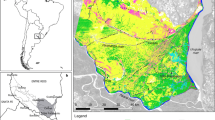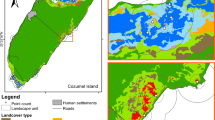Abstract
Forested wetlands are important habitat for many bird species, but data about area and habitat relationships of birds in depressional (i.e., non-riverine) deciduous forested wetlands are scarce. Depressional forested wetlands are often surrounded by larger, continuous patches of upland forest, and it is not clear whether this surrounding forest should be considered part of the forested wetland. To contribute regional data to this question, we sampled birds and vegetation in depressional forested wetlands in southern Michigan, USA. Results indicated that the wetland per se should not be considered separate from the surrounding forest because forest area and forest characteristics were the most important predictors of richness and abundance of wetland-associated birds. Conversely, wetland area and wetland characteristics were important for some upland species. Because spatial clustering and model selection uncertainty are often encountered by wetland scientists, we describe analytical methods used to deal with these problems.
Similar content being viewed by others
Literature Cited
Abernathy, Y. and R. E. Turner. 1987. U. S. Forested Wetlands: 1940–1980. BioScience 37: 721–727.
American Ornithologist’s Union. 1998. Check-list of North American Birds, 7th edition. American Ornithologist’s Union, Lancaster, PA, USA.
American Ornithologist’s Union. 2003. Forty-fourth supplement to the American Ornithologist’s Union check-list of North American birds. Auk 117: 847–858.
Austin, M. P., J. G. Pausas, and A. O. Nicholls. 1996. Patterns of tree species richness in relations to environment in southeastern New South Wales, Australia. Australian Journal of Ecology 21: 154–164.
Barnes, B. V. 1976. Succession in deciduous swamp communities of southeastern Michigan formerly dominated by American elm. Canadian Journal of Botany 54: 19–24.
Brewer, R., G. A. McPeek, and R. J. Adams. 1991. The Atlas of Breeding Birds of Michigan. Michigan State University Press, East Lansing, MI, USA.
Bennetts, R. E., W. M. Kitchens, and V. J. Dreitz. 2002. Influence of an extreme high water event on survival, reproduction and distribution of snail kites in Florida, USA. Wetlands 22: 366–373.
Bentley, J. M. and C. P. Catterall. 1997. The use of brushland, corridors and linear remnants by birds in southeastern Queensland, Australia. Conservation Biology 11: 1173–1189.
Burham, K. P. and D. R. Anderson. 2002. Model Selection and Multimodel Inference: a Practical Information-theoretic Approach. Springer-Verlag, New York, NY, USA.
Cowardin, L. M., V. Carter, F. C. Golet, and E. T. LaRoe. 1980. Classification of wetlands and deep-water habitats of the United States. U. S. Fish and Wildlife Service, Washington, DC, USA. FWS/OBS-79/31.
Dowd, C. 1992. Effect of development on bird species composition of two urban forested wetlands in Staten Island, New York. Journal of Field Ornithology 63: 455–461.
Eggers, S. D. and D. M. Reed. 1997. Wetland plants and communities of Minnesota and Wisconsin. U.S. Army Corps of Engineers, St. Paul District. Northern Prairie Wildlife Research Center Home Page. http://www.npwrc.usgs.gov/resource/1998/mnplant/ mnplant.htm (Version 03SEP98).
Fellows, D. P. and T. K. Buhl. 1995. Research access to privately owned wetland basins in the prairie pothole region of the United States. Wetlands 15: 330–335.
Flack, V. F. and P. C. Chang. 1987. Frequency of selecting noise variables in subset regression analysis: a simulation study. American Statistician 41: 84–86.
Forman, R. T. T., D. Sperling, J. A. Bissonette, A. P. Clevenger, C. D. Cutshall, V. H. Dale, L. Fahrig, R. France, C. R. Goldman, K. Heanue, J. A. Jones, F. J. Swanson, T. Turrentine, and T. C. Winter. 2003. Road Ecology: Science and Solutions. Island Press, Washington, DC, USA.
Golet, F. C., Y. Wang, J. S. Merrow, and W. R. DeRagon. 2001. Relationship between habitat and landscape features and the avian community of red maple swamps in southern Rhode Island. Wilson Bulletin 113: 217–227.
Gutzwiller, K. J., R. T. Wiedenmann, K. L. Clements, and S. H. Anderson. 1994. Effects of human intrusion on song occurrence and singing consistency in subalpine birds. Auk 111: 28–37.
Hartig, E. K., V. Gornitz, A. Kolker, F. Mushacke, and D. Fallon. 2002. Anthropogenic and climate-change impacts on salt marshes of Jamaica Bay, New York City. Wetlands 22: 71–89.
Hatcher, L. 1998. A Step-by-Step Approach to Using the SAS System for Factor Analysis and Structural Equation Modeling. SAS Institute, Cary, NC, USA.
Hohn, M. E. 1988. Geostatistics and Petroleum Geology. Van Nostrand Reinhold, New York, NY, USA.
Hurvich, C. M. and C. Tsai. 1989. Regression and time series model selection in small samples. Biometrika 76: 297–307.
Hutto, R. J., S. M. Pletschet, and P. Hendricks. 1986. A fixed-radius point count for non-breeding and breeding season use. Auk 103: 593–602.
Inman, R. L., H. H. Prince, and D. B. Hayes. 2002. Avian communities in forested riparian wetlands of southern Michigan, USA. Wetlands 22: 647–660.
Kilgo, J. C., K. V. Miller, and W. P. Smith. 1999. Effects of groupselection timber harvest in bottomland hardwoods on fall migrant birds. Journal of Field Ornithology 70: 404–413.
Laird, N. M. and J. H. Ware. 1982. Random-effects models of longitudinal data. Biometrics 38: 963–974.
Lesser, V. M. 2001. Applying survey research methods to account for denied access to research sites on private property. Wetlands 21: 639–647.
Littell, R. C., G. A. Milliken, W. W. Stroup, and R. D. Wolfinger. 1996. SAS System for Mixed Models. SAS Institute, Cary, NC, USA.
Loyn, R. H. 1980. Bird populations in a mixed eucalypt forest used for production of wood in Gippsland, Victoria. Emu 80: 145–156.
MacArthur, R. H. and E. O. Wilson. 1967. The Theory of Island Biogeography. Princeton University Press, Princeton, NJ, USA.
Mac Nally, R., T. R. Sonderquist, and C. Tzaros. 2000. The conservation value of mesic gullies in dry forest landscapes: avian assemblages in the box-ironbark ecosystem of southern Australia. Biological Conservation 93: 293–302.
Morrison, M. L., B. G. Marcot, and R. W. Mannan. 1998. Wildlifehabitat Relationships: Concepts and Applications. University of Wisconsin Press, Madison, WI, USA.
National Research Council. 2002. Riparian Areas: Functions and Strategies for Management. National Academy Press, Washington DC, USA.
Nichols, J. D., J. E. Hines, J. R. Sauer, F. W. Fallon, J. E. Fallon, and P. J. Heglund. 2000. A double-observer approach for estimating detection probability and abundance from point counts. Auk 117: 393–408.
Perkins, M. W., R. J. Johnson, and E. E. Blakenship. 2003. Response of riparian avifauna to percentage and pattern of woody cover in an agricultural landscape. Wildlife Society Bulletin 31: 642–660.
Ralph, C. J., J. R. Sauer, and S. Droege [Technical eds.]. 1995. Monitoring bird populations by point counts. USDA Forest Service, Pacific Southwest Research Station, Albany, CA, USA. Gen. Tech. Rep. PSW-GTR-149.
Rencher, A. C. 1992. Interpretation of canonical discriminant functions, canonical variates, and principal components. American Statistician 46: 217–225.
Riffell, S. K., K. J. Gutzwiller, and S. H. Anderson. 1996. Does repeated human intrusion cause cumulative declines in avian richness and abundance. Ecological Applications 6: 492–505.
Riffell, S. K., B. E. Keas, and T. M. Burton. 2001. Area and habitat relationships of birds in Great Lakes coastal wet meadows. Wetlands 21: 492–507.
Riffell, S. K. and B. D. Riffell. 2002. Can observer clothing color bias richness and abundance variables? An experiment with point counts. Journal of Field Ornithology 73: 351–359.
Rotenberry, J. T. and J. A. Wiens. 1980. Habitat structure, patchiness, and avian communities in North American steppe vegetation: a multivariate analysis. Ecology 61: 1228–1250.
Saab, V. 1999. Importance of spatial scale to habitat use by breeding birds in riparian forests: a hierarchical analysis. Ecological Applications 9: 135–151.
Sallabanks, R., J. R. Walters, and J. A. Collazo. 2000. Breeding bird abundance in bottomland hardwood forest: habitat, edge, and patch size effects. Condor 102: 748–758.
SAS Institute, Inc. 1996. SAS/STAT technical report: spatial prediction using the SAS system. SAS Institute, Cary, NC, USA.
SAS Institute, Inc. 1999. SAS/STAT user’s guide, volume 2, version 8 edition. SAS Institute, Cary, NC, USA.
Selmi, S. and T. Boulinier. 2001. Ecological biogeography of southern ocean islands: the importance of considering spatial issues. American Naturalist 158: 426–437.
Smith, R., M. Hamas, M. Dallman, and D. Ewert. 1998. Spatial variation in foraging of the black-throated green warbler along the shoreline of northern Lake Huron. Condor 100: 474–484.
Streever, W. J., K. M. Perier, and T. L. Crisman. 1996. A comparison of dipterans from ten created and ten natural wetlands. Wetlands 16: 416–428.
Swift, B. L., J. S. Larson, and R. M. DeGraaf. 1984. Relationship of breeding bird density and diversity to habitat variables in forested wetlands. Wilson Bulletin 96: 48–59.
Timoney, K. S., C. Zoltai, and G. Goldsborough. 1997. Boreal diatom ponds: a rare wetland associated with nesting whooping cranes. Wetlands 17: 359–551.
Twedt, D. J., R. R. Wilson, J. L. Henne-Kerr, and D. A. Grosshuesch. 2002. Avian response to bottomland hardwood reforestation: the first 10 years. Restoration Ecology 10: 645–655.
Whitaker, D. M. and W. A. Montevecchi. 1997. Breeding bird assemblages associated with riparian, interior forest, and nonriparian edge habitats in a balsam fir ecosystem. Canadian Journal of Forest Research 27: 1159–1167.
Wilcox, D. A., J. E. Meeker, P. L. Hudson, B. J. Armitage, M. G. Black, and D. G. Uzarski. 2002. Hydrologic variability and the application of index of biotic integrity metrics to wetlands: a Great Lakes evaluation. Wetlands 22: 588–615.
Woo, I. and J. B. Zedler. 2002. Can nutrients alone shift a sedge meadow towards dominance by the invasive Typha X glauca? Wetlands 22: 509–521.
Zar, J. H. 1999. Biostatistical Analysis. Prentice-Hall, Upper Saddle River, NJ, USA.
Author information
Authors and Affiliations
Corresponding author
Rights and permissions
About this article
Cite this article
Riffell, S., Burton, T. & Murphy, M. Birds in depressional forested wetlands: Area and habitat requirements and model uncertainty. Wetlands 26, 107–118 (2006). https://doi.org/10.1672/0277-5212(2006)26[107:BIDFWA]2.0.CO;2
Received:
Revised:
Accepted:
Issue Date:
DOI: https://doi.org/10.1672/0277-5212(2006)26[107:BIDFWA]2.0.CO;2




